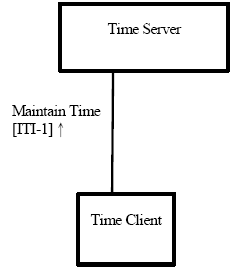Difference between revisions of "Consistent Time"
m (→See Also) |
JohnMoehrke (talk | contribs) |
||
| (13 intermediate revisions by 5 users not shown) | |||
| Line 1: | Line 1: | ||
The '''Consistent Time Integration''' Profile (CT) provides a means to ensure that the system clocks and time stamps of the many computers in a network are well synchronized. This profile specifies synchronization with a median error less than 1 second. This is sufficient for most purposes. | The '''Consistent Time Integration''' Profile (CT) provides a means to ensure that the system clocks and time stamps of the many computers in a network are well synchronized. This profile specifies synchronization with a median error less than 1 second. This is sufficient for most purposes. | ||
| − | + | __TOC__ | |
| − | |||
==Summary== | ==Summary== | ||
| Line 18: | Line 17: | ||
Where ''hostname'' is the host name or IP address of the time server. | Where ''hostname'' is the host name or IP address of the time server. | ||
| + | |||
| + | |||
| + | To ensure that your clock is updated immediately, stop the windows time service, set your clock back 5 minutes, then set the hostname, and restart your time service. | ||
| + | |||
| + | C:\> net stop w32time | ||
| + | C:\> time | ||
| + | C:\> net time /setsntp:''hostname'' | ||
| + | C:\> net start w32time | ||
=== Unix Client Configuration === | === Unix Client Configuration === | ||
| Line 33: | Line 40: | ||
* [[Time Client]] | * [[Time Client]] | ||
* [[Time Server]] | * [[Time Server]] | ||
| + | |||
| + | ==Specification== | ||
| + | Profile Status: [[Comments| Final Text]] | ||
| + | |||
| + | [http://www.ihe.net/Technical_Framework/index.cfm#IT IHE IT Infrastructure Technical Framework Version 1 or later] | ||
| + | :* [http://www.ihe.net/uploadedFiles/Documents/ITI/IHE_ITI_TF_Vol1.pdf#nameddest=7_Consistent_Time__CT_ Vol. 1 - Section 7] | ||
| + | :* [http://www.ihe.net/uploadedFiles/Documents/ITI/IHE_ITI_TF_Vol2a.pdf#nameddest=3_1_Maintain_Time__ITI_1_ Vol. 2a - Sections 3.1] | ||
| + | |||
| + | Underlying Standards: | ||
| + | :* NTP Network Time Protocol Version 3. RFC1305 | ||
| + | :* SNTP Simple Network Time Protocol (SNTP) RFC2030 | ||
==See Also== | ==See Also== | ||
| − | |||
| − | |||
| − | [http://www.ntp.org/ The Network Time Protocol] | + | * [http://www.ntp.org/ The Network Time Protocol] site provides an open source implementation of the NTP protocol. |
| + | |||
| + | * [http://tf.nist.gov/service/time-servers.html NIST] provides several time servers in the US that can be used to synchronize a system's internal clock. | ||
| + | |||
| + | * [http://www.pool.ntp.org/en/ ntp.pool.org] is the international pool of NTP servers set up to distribute and share the load on time servers. | ||
| + | |||
| + | |||
| + | A [http://www.economist.com/blogs/babbage/2012/05/medical-devices May 2012 Economist article] commented on the persistent need for time synchronization of medical devices. | ||
| − | |||
The [[CT FAQ]] answers typical questions about what the Profile does. | The [[CT FAQ]] answers typical questions about what the Profile does. | ||
| Line 48: | Line 70: | ||
[[Category:Profiles]] | [[Category:Profiles]] | ||
| + | [[Category:ITI Profile]] | ||
| + | [[Category:Security]] | ||
Revision as of 14:29, 7 August 2017
The Consistent Time Integration Profile (CT) provides a means to ensure that the system clocks and time stamps of the many computers in a network are well synchronized. This profile specifies synchronization with a median error less than 1 second. This is sufficient for most purposes.
Summary
The Consistent Time Integration Profile defines mechanisms to synchronize the time base between multiple actors and computers.
Benefits
Various infrastructure, security, and acquisition profiles require use of a consistent time base on multiple computers, to synchronize logs, authenticate users, digitally sign documents, et cetera.
Details
The Consistent Time profile requires the use of the Network Time Protocol (NTP) defined in RFC 1305. When the Time Server is grouped with a Time Client to obtain time from a higher tier Time Server, the Time Client shall utilize NTP. For some Time Clients that are not grouped with a Time Server, SNTP (see RFC 4330) may be usable.
Windows Client Configuration
To configure Windows system to be a time client, simply enter the following at the command line:
C:\> net time /setsntp:hostname
Where hostname is the host name or IP address of the time server.
To ensure that your clock is updated immediately, stop the windows time service, set your clock back 5 minutes, then set the hostname, and restart your time service.
C:\> net stop w32time C:\> time C:\> net time /setsntp:hostname C:\> net start w32time
Unix Client Configuration
On a unix system, ask a sysadmin to ensure that ntpd is running and configured properly. Typically, this involves ensuring that /etc/ntp.conf contains the following line:
server hostname
Where hostname is the host name or IP address of the time server.
Systems Affected
All
Actors
Specification
Profile Status: Final Text
IHE IT Infrastructure Technical Framework Version 1 or later
Underlying Standards:
- NTP Network Time Protocol Version 3. RFC1305
- SNTP Simple Network Time Protocol (SNTP) RFC2030
See Also
- The Network Time Protocol site provides an open source implementation of the NTP protocol.
- NIST provides several time servers in the US that can be used to synchronize a system's internal clock.
- ntp.pool.org is the international pool of NTP servers set up to distribute and share the load on time servers.
A May 2012 Economist article commented on the persistent need for time synchronization of medical devices.
The CT FAQ answers typical questions about what the Profile does.
This page is based on the Profile Template
